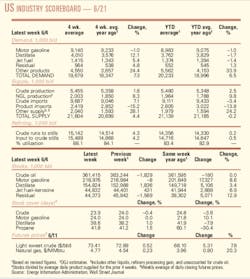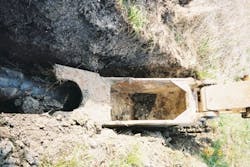OGJ Newsletter
BOEMRE to use teams for offshore inspections
The US Bureau of Offshore Energy Management, Regulation, and Enforcement will begin using multiperson teams for offshore oil and gas inspections, BOEMRE Director Michael R. Bromwich announced. The internal process improvement will let teams inspect multiple operations simultaneously and thoroughly, enhancing the quality of inspections on larger facilities, he said.
"We are bolstering our inspection program with additional resources and new approaches," Bromwich explained on June 13. "As more inspectors are hired, we will be deploying multidisciplinary inspection teams instead of individual inspectors, providing broader oversight to ensure that offshore operators are complying with federal regulations and conducting their operations in a safe and environmentally responsible manner."
He said reviews and inspections by US President Barack Obama's independent oil spill commission, the US Department of the Interior's Office of Inspector General, DOI's Safety Oversight Board, and numerous US House and Senate committees have highlighted the need to reform BOEMRE's inspections program.
In addition to on-the-job training, BOEMRE recently established the National Offshore Training Center and is training inspectors with the agency's first formal training curriculum. It recently held an initial introductory course for 13 inspectors and plans to develop 24 more courses covering specific offshore inspections areas. BOEMRE also is looking for someone to direct the training program, it said.
It said that the multidisciplinary team approach and the need for a national training program were recommended by BOEMRE's inspections strategies implementation team, one of several internal teams that have been analyzing critical aspects of the agency's structures, functions and processes, and implementing needed changes.
BOEMRE will continue to focus its recruiting efforts to attract more subject matter experts to bolster existing expertise in the bureau's district offices, it said. Specifically, the bureau said that it wants to expand expertise in well operations, production operations, safety and environmental management systems, accident investigations, measurement systems, and deepwater drilling.
The agency presently has 79 inspectors working in the Gulf of Mexico, up from 54 on Apr. 20, and has 5 more in different phases of the hiring process, a BOEMRE spokesman told OGJ.
Environmental groups sue BOEMRE over well permit
Earthjustice, the former Sierra Club legal defense fund, sued the US Bureau of Ocean Energy Management, Regulation, and Enforcement June 9 in federal court in New Orleans for approving Shell Oil Co.'s request for a deepwater drilling permit near the site of BP PLC's 2010 Macondo well accident and crude oil spill.
The group's suit on behalf of the Gulf Restoration Foundation, the Florida Wildlife Federation, and the Sierra Club charged that BOEMRE's risk calculations were flawed and Shell's drilling plan was not sufficient to protect communities along the US Gulf Coast. It said BOEMRE based its analysis on a 1-in-4,000 chance oil spill risk scenario, even though industry documents show the chance of a major spill at 1-in-43.
"It is as if the government regulators have learned nothing from the BP disaster," said Earthjustice attorney David Guest. "Before new deepwater gulf drilling occurs, the government must make a realistic assessment of the risk to the gulf's ecosystem, its communities, and the many jobs that depend on tourism, fishing, and recreation. It has utterly failed to do so here."
BOEMRE did not immediately comment on the lawsuit. National Ocean Industries Association Pres. Randall B. Luthi said that it was misguided.
"Since the Macondo well accident, the entire offshore energy industry has worked tirelessly to assure that all exploration and development is done in accordance with new safety rules and additional safety reviews put in place by industry," he said on June 9. "Yet the plaintiff environmental groups are in an all-out sprint to prevent the nation from safely realizing the potential of these vast oil and gas resources off our Gulf Coast. These are the same type of artificial roadblocks we have seen in Alaska."
Cardinal Gas Storage to acquire Monroe Gas Storage
Cardinal Gas Storage Partners LLC acquired Monroe Gas Storage Company LLC and an option to develop an adjacent depleted natural gas reservoir from High Sierra Monroe LLC, a subsidiary of High Sierra Energy.
Total consideration was $148 million. Monroe, a gas storage company in northeast Mississippi, has two pipeline interconnects through a separate east and west header system to Tennessee Gas Pipeline and Texas Eastern Pipeline.
Cardinal is a joint venture between Redbird Gas Storage LLC and funds controlled by Energy Capital Partners LLC.
Kurdistan to assess regional oil, gas reserves
The Ministry of Natural Resources of the Kurdistan Regional Government is conducting its first survey of regional oil and gas reserves to be used in conjunction with Iraqi federal authorities for reporting of countrywide reserves, said DNO International ASA, Oslo.
DNO has been asked urgently to submit its current estimates for both resources and reserves in the three contract areas it operates in Kurdistan. DNO has been undertaking a revision of the reserves at Tawke field based on recent production history and updated geological and reservoir models and expects to report large increases, said Helge Eide, managing director.
"Based on our current estimates we expect the gross ultimate P50 recoverable reserves for Tawke to be in excess of 500 million bbl," Eide said. The figure is far higher than previous management estimates of 387 million bbl, for which the comparable externally audited figure was 306 million bbl.
With the resumption of exports of oil from Kurdistan in February, DNO said, Tawke production has climbed rapidly and has been sustained at about 70,000 b/d.
Eide said, "While reserves estimates are a work in progress and subject to change as new information is obtained, Tawke is certainly exceeding our expectations in terms of deliverability and field size. We are very excited and pleased with what we are learning."
Other work is under way to estimate the size of the Benenan and Bastora discoveries as well as the potential of all undrilled prospects and geological horizons in DNO's licenses in Kurdistan.
DNO has commissioned Beicip Franlab, Paris, to provide a new interim Tawke report based on the latest production history and the company's updated models, Eide said.
Andes to explore Argentine Nirihuau basin block
The Chubut government oil and gas concern Petrominera Chubut SE has awarded the Nirihuau Sur CN-1 block to a joint venture of Andes Energia Argentina SA and Kilwer SA.
The 4,538 sq km block is in the northwest part of Chubut Province in the Nirihuau basin, which has geology similar to that of the Neuquen basin to the north and San Jorge basin to the southeast. Andes SA holds a 60% economic interest, Kilwer has 20%, and Petrominera Chubut has a 20% carried interest.
Oil springs are well known in the Nirihuau basin. A shallow well located 31 km west of the block supplies gas to a village. A neighboring block was awarded to YPF-Pluspetrol. The exploratory interest arises from a model supported by geochemical studies, surface data, and chronological data that indicate the presence of a petroleum system (Tertiary El Foyel Group), which would explain the origin of the oil springs, Andes Energia said.
Work program in the first 3 years of the 6-year license calls for collection of 3,000 geochemical samples, shooting 50 km of 2D seismic, and reprocessing of a further 150 km of 2D.
The award brings Andes' interests in Argentina to 11 licenses totaling more than 30,000 sq km. YPF has taken farmouts from Andes on eight of the licenses.
Drilling & Production — Quick TakesMWCC raises containment stack depth to 10,000 ft
Marine Well Containment Co. (MWCC) said its interim capping stack now can meet the requirements for operations in water depths up to 10,000 ft, which is an increase from the previous 8,000 ft water depth limit.
"This increase in our capability demonstrates our commitment to providing a comprehensive deepwater well containment system for the US Gulf of Mexico," said MWCC Chief Executive Officer Marty Massey.
The capping stack is designed to cap or contain hydrocarbon flow after a deepwater well control incident. It can handle pressures of up to 15,000 psi.
MWCC explains that the capping stack provides a dual barrier for containment through a blowout preventer ram and a containment cap. Through its side valves, the capping stack can also redirect fluid flow to surface vessels through flexible pipes and risers, if necessary.
MWCC has tested the capping and maintains it in a continuous state of readiness for mobilization. The stack has a height of about 30-ft and a width of 14-ft. It weighs almost 100 tons.
A Shell permit application, which cited the MWCC interim system for drilling in 9,800 ft of water in the Tobago field, met the requirements of the US Bureau of Ocean Energy, Management, Regulation, and Enforcement and was approved.
MWCC said its expanded containment system is on track for delivery in 2012. In addition to operating in water depth up to 10,000 ft, the expanded system will have the capacity to capture up to 100,000 bbl of fluid and 200 MMcfd of gas.
Statoil to start Visund South development
Statoil has received approval to develop Visund South oil field in the Tampen area of the Norwegian North Sea and will start drilling in August.
The project is part of Statoil's fast-track program for small and medium-size fields. Development will involve installation this month of a four-slot subsea template from which three wells will be drilled and tied back to the Gullfaks C platform 10 km away for processing.
Production start is scheduled for the third quarter of 2012.
The field is 10 km south of Visund oil and gas field, a development based on wells completed subsea and a floating production, drilling, and quarters platform.
Visund South incorporates the Pan and Pandora discoveries of 2008-09. The reservoir is estimated to contain 67 million boe—one-third oil and two-thirds gas. The reservoir, with 340 bar reservoir pressure, lies 2,900 m below the seabed under 290 m of water.
Statoil, operator with 53.2% interest, expects Visund South to produce for more than 15 years.
PROCESSING — Quick TakesFirst cargo of Pearl GTL products ship from Qatar
Royal Dutch Shell PLC and Qatar Petroleum reported the Pearl gas-to-liquids plant in Qatar's Ras Laffan Industrial City sold its first commercial shipment of GTL gas oil.
The sale marked the start of production of GTL products from the plant. In coming months, production is to ramp up from the Pearl GTL project's first train, and the second train is expected to start up before yearend. The plant is expected to reach full production capacity by mid-2012. It is the largest energy project ever launched in Qatar, officials said.
Qatar's Minister of Energy and Industry Mohammed bin Saleh Al-Sada said the project will enhance diversification of North field gas utilization and will optimize Qatar's competitive position in world markets.
When fully operational, Pearl GTL is expected to produce 1.6 bcfd from North field, which will be processed to deliver an expected 120,000 b/d of condensate, LPG, and ethane, plus an expected 140,000 b/d GTL products using Shell's technological and project management capabilities.
Shell is operator of the Pearl GTL plant under a development and production-sharing agreement with Qatar. The project was launched in July 2006.
Major construction was completed last year. On Mar. 23, gas began flowing to the project from wells 60 km offshore. The gas processing plant began producing condensate, LPG, and sulfur. Four of the world's largest air separation units began producing oxygen for the GTL plant that employs Shell proprietary technology to convert the gas and oxygen to GTL wax. In the last step of the process, the waxes are cracked and distilled into finished GTL products.
Penn Virginia buys Granite Wash gas plant
Penn Virginia Resource Partners LP, Radnor, Pa., paid $11.4 million for a natural gas gathering system and processing plant in the Texas Panhandle. The company's announcement did not name the seller, nor did the company respond to a request to identify it.
The Antelope Hills assets consist of 20 MMcfd of cryogenic processing and about 15 miles of gas gathering in Lipscomb and Hemphill counties. These assets, which are currently connected to PVR's existing Panhandle systems, will serve producers in the Granite Wash.
This acquisition is part of a larger PVR Panhandle systems expansion that the company said will involve expansion of the Antelope Hills processing plant to 70 MMcfd, as well as additional gathering system "enhancement and optimization."
The planned expansion will involve an additional investment of about $35 million over the next 12 months, said the company announcement, and will increase PVR's Panhandle total processing capacity to 330 MMcfd.
Penn Virginia Resource Partners owns more than 800 million tons of proven coal reserves in northern and central Appalachia and the Illinois and San Juan basins. Its midstream natural gas assets are principally in Texas, Oklahoma, and Pennsylvania and include more than 4,200 miles of gas gathering pipelines and seven processing systems with about 420 MMcfd of capacity.
TRANSPORTATION — Quick TakesDunkerque LNG awards EPC for LNG terminal
Dunkerque LNG, a subsidiary of Electricite de France SA (EDF), has awarded Sener Ingenieria y Sistemas an engineering, procurement, and construction contract to develop a regasification terminal in Dunkerque in northern France.
The Dunkerque terminal will have three 190,000-cu m storage tanks and be able to produce 13 billion cu m/year of natural gas, according to the Sener announcement. Sener received the EPC contract as part of the TS LNG consortium, which consists of Sener and Techint.
The terminal will be equipped with a jetty, unloading arms and pipes, storage tanks, systems for regasification and gas emission, a boil-off gas recovery system, a flare stack, a seawater pump system for vaporization, auxiliary systems, and a series of offices, control buildings, safety facilities, and shops specifically designed for operations.
Within the TS LNG consortium, Sener will develop all of basic and detailed engineering, acquire equipment and build civil works, buildings, jetty, unloading pipes, and the regasification plant and coordinate with consortium in charge of tanks and tunnel. It will also conduct all commissioning and start-up of the terminal. Construction will take 4 years, with the plant starting up in 2015.
As part of this consortium, Sener is also finalizing construction of the GATE LNG terminal in Rotterdam, with an export capacity of up to 16 billion cu m/year plus another 20% at peak, said the company, and with four storage tanks.
DCP ups Conway-Mont Belvieu NGL capacity
DCP Midstream will acquire the Seaway Products Pipeline Co. from ConocoPhillips, rename it the Southern Hills Pipeline, and convert it from refined products service to NGL service covering the more than 700 miles between NGL market hubs at Conway, Kan., and Mont Belvieu, Tex.
DCP Midstream will add a 130-mile extension from the pipeline's current northern terminus to Conway and a 30-mile extension to Mont Belvieu, as well as pump capacity and associated gathering infrastructure to the current 580-mile pipeline. The pipeline will have a capacity of 150,000 b/d of Y-grade NGL, and be connected to several DCP Midstream processing plants and anticipated third-party NGL producers.
DCP Midstream will operate Southern Hills as a common carrier pipeline. The company expects it to enter service as early as mid-2013. DCP Midstream expects to announce a request for a nonbinding expression of interest in the pipeline from shippers later this year. The acquisition and conversion will cost a total of $750-850 million.
DCP Midstream also entered into preliminary agreements with Occidental Petroleum Corp. for Oxy's wholly owned subsidiary Occidental Chemical Corp. to provide right-of-way for the DCP Midstream Sandhills Pipeline LLC and for DCP to provide a supply option for a proposed new Oxy NGL fractionator in Ingleside, Tex.
The agreement with OxyChem will provide the Sandhills system with 14 miles of right-of-way and access to the Mont Belvieu fractionation complex. It also will help keep the Sandhills Pipeline project on track for a first-half 2013 start-up, DCP Midstream said.
DCP Midstream is in the process of securing the remaining right-of-way and environmental permits for Sandhills. The new 700-mile pipeline system will transport Y-grade NGL from gas plants in the Permian basin and South Texas to various fractionator facilities along the Gulf Coast, including Mont Belvieu.
Sandhills will ship gas from DCP's 200-MMcfd Eagle gas plant, designed to serve the Eagle Ford shale gas development.
DCP Midstream says it is also securing long-term commitments from third-party shippers. DCP has completed deals with West Texas LPG Pipeline LP to provide NGL gathering services for Sandhills through points with West Texas LPG.
More Oil & Gas Journal Current Issue Articles
More Oil & Gas Journal Archives Issue Articles
View Oil and Gas Articles on PennEnergy.com





